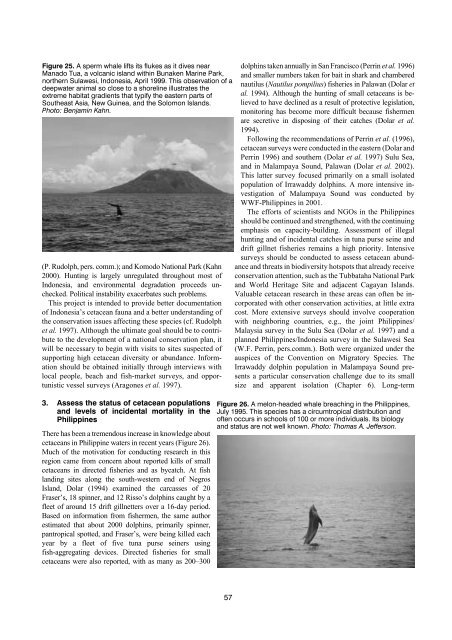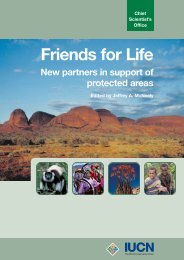Dolphins, Whales and Porpoises: 2002-2010 Conservation - IUCN
Dolphins, Whales and Porpoises: 2002-2010 Conservation - IUCN
Dolphins, Whales and Porpoises: 2002-2010 Conservation - IUCN
Create successful ePaper yourself
Turn your PDF publications into a flip-book with our unique Google optimized e-Paper software.
Figure 25. A sperm whale lifts its flukes as it dives near<br />
Manado Tua, a volcanic isl<strong>and</strong> within Bunaken Marine Park,<br />
northern Sulawesi, Indonesia, April 1999. This observation of a<br />
deepwater animal so close to a shoreline illustrates the<br />
extreme habitat gradients that typify the eastern parts of<br />
Southeast Asia, New Guinea, <strong>and</strong> the Solomon Isl<strong>and</strong>s.<br />
Photo: Benjamin Kahn.<br />
(P. Rudolph, pers. comm.); <strong>and</strong> Komodo National Park (Kahn<br />
2000). Hunting is largely unregulated throughout most of<br />
Indonesia, <strong>and</strong> environmental degradation proceeds unchecked.<br />
Political instability exacerbates such problems.<br />
This project is intended to provide better documentation<br />
of Indonesia’s cetacean fauna <strong>and</strong> a better underst<strong>and</strong>ing of<br />
the conservation issues affecting these species (cf. Rudolph<br />
et al. 1997). Although the ultimate goal should be to contribute<br />
to the development of a national conservation plan, it<br />
will be necessary to begin with visits to sites suspected of<br />
supporting high cetacean diversity or abundance. Information<br />
should be obtained initially through interviews with<br />
local people, beach <strong>and</strong> fish-market surveys, <strong>and</strong> opportunistic<br />
vessel surveys (Aragones et al. 1997).<br />
3. Assess the status of cetacean populations<br />
<strong>and</strong> levels of incidental mortality in the<br />
Philippines<br />
There has been a tremendous increase in knowledge about<br />
cetaceans in Philippine waters in recent years (Figure 26).<br />
Much of the motivation for conducting research in this<br />
region came from concern about reported kills of small<br />
cetaceans in directed fisheries <strong>and</strong> as bycatch. At fish<br />
l<strong>and</strong>ing sites along the south-western end of Negros<br />
Isl<strong>and</strong>, Dolar (1994) examined the carcasses of 20<br />
Fraser’s, 18 spinner, <strong>and</strong> 12 Risso’s dolphins caught by a<br />
fleet of around 15 drift gillnetters over a 16-day period.<br />
Based on information from fishermen, the same author<br />
estimated that about 2000 dolphins, primarily spinner,<br />
pantropical spotted, <strong>and</strong> Fraser’s, were being killed each<br />
year by a fleet of five tuna purse seiners using<br />
fish-aggregating devices. Directed fisheries for small<br />
cetaceans were also reported, with as many as 200–300<br />
57<br />
dolphins taken annually in San Francisco (Perrin et al. 1996)<br />
<strong>and</strong> smaller numbers taken for bait in shark <strong>and</strong> chambered<br />
nautilus (Nautilus pompilius) fisheries in Palawan (Dolar et<br />
al. 1994). Although the hunting of small cetaceans is believed<br />
to have declined as a result of protective legislation,<br />
monitoring has become more difficult because fishermen<br />
are secretive in disposing of their catches (Dolar et al.<br />
1994).<br />
Following the recommendations of Perrin et al. (1996),<br />
cetacean surveys were conducted in the eastern (Dolar <strong>and</strong><br />
Perrin 1996) <strong>and</strong> southern (Dolar et al. 1997) Sulu Sea,<br />
<strong>and</strong> in Malampaya Sound, Palawan (Dolar et al. <strong>2002</strong>).<br />
This latter survey focused primarily on a small isolated<br />
population of Irrawaddy dolphins. A more intensive investigation<br />
of Malampaya Sound was conducted by<br />
WWF-Philippines in 2001.<br />
The efforts of scientists <strong>and</strong> NGOs in the Philippines<br />
should be continued <strong>and</strong> strengthened, with the continuing<br />
emphasis on capacity-building. Assessment of illegal<br />
hunting <strong>and</strong> of incidental catches in tuna purse seine <strong>and</strong><br />
drift gillnet fisheries remains a high priority. Intensive<br />
surveys should be conducted to assess cetacean abundance<br />
<strong>and</strong> threats in biodiversity hotspots that already receive<br />
conservation attention, such as the Tubbataha National Park<br />
<strong>and</strong> World Heritage Site <strong>and</strong> adjacent Cagayan Isl<strong>and</strong>s.<br />
Valuable cetacean research in these areas can often be incorporated<br />
with other conservation activities, at little extra<br />
cost. More extensive surveys should involve cooperation<br />
with neighboring countries, e.g., the joint Philippines/<br />
Malaysia survey in the Sulu Sea (Dolar et al. 1997) <strong>and</strong> a<br />
planned Philippines/Indonesia survey in the Sulawesi Sea<br />
(W.F. Perrin, pers.comm.). Both were organized under the<br />
auspices of the Convention on Migratory Species. The<br />
Irrawaddy dolphin population in Malampaya Sound presents<br />
a particular conservation challenge due to its small<br />
size <strong>and</strong> apparent isolation (Chapter 6). Long-term<br />
Figure 26. A melon-headed whale breaching in the Philippines,<br />
July 1995. This species has a circumtropical distribution <strong>and</strong><br />
often occurs in schools of 100 or more individuals. Its biology<br />
<strong>and</strong> status are not well known. Photo: Thomas A. Jefferson.






